Mechanical or hydraulic disc brakes on a bike? In this article you will learn the advantages and disadvantages of each brake system. At the beginning you will learn the basic knowledge and the most important considerations about the two braking systems. In the second part you will learn 13 tips about disc brakes in practice.
quick overview: Mechanical vs Hydraulic Disc Brakes
When it comes to maximum braking power, the hydraulic disc brake is clearly ahead. Are there also reasons that speak for a mechanical disc brake? What are the advantages and disadvantages of both braking systems?
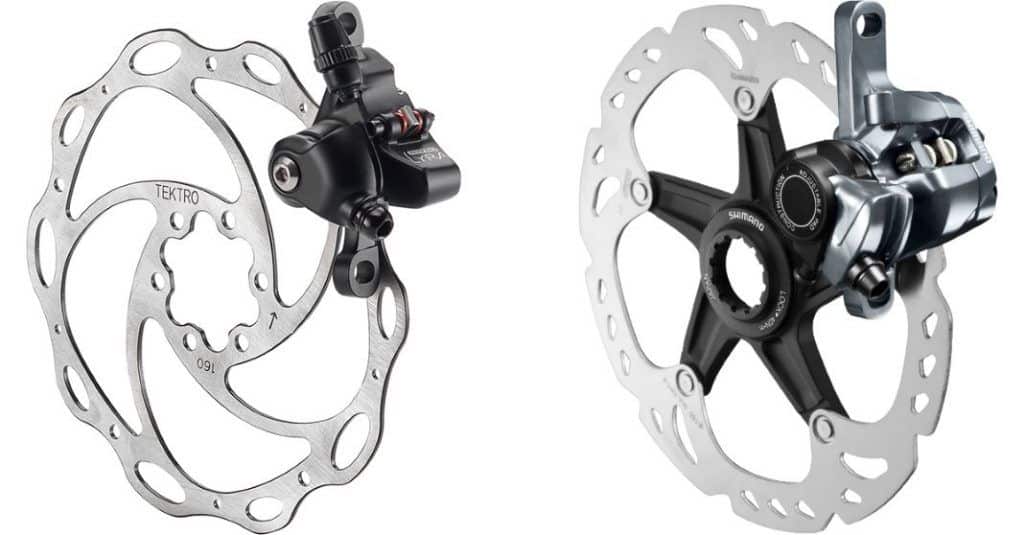
Mechanical disc brakes
✅ Easy mounting
✅ Good but not outstanding braking performance
✅ Cheaper in comparison
✅ Lower weight
❌ Braking power more difficult to dose: Brake feel comparable to “all or nothing”.
❌ Can be serviced by yourself in remote areas in the event of a defect: An Allen key or a multitool with Allen key is sufficient
❌ Brake levers have wide compatibility: almost every brake lever for mechanical brakes works – also brake levers for rim brakes
❌ Lower braking power due to friction in the Bowden cable. Braking performance does not come close to that of hydraulic disc brakes
❌ Must be readjusted regularly by yourself to maintain braking performance: normally every approx. 500 to 1000 kilometres.
Hydraulic disc brakes
✅ Maximum braking power
✅ Braking power well controllable and controllable
Low maintenance: brake pads adjust automatically. This ensures optimum braking performance at all times
Self-contained system: dirt and moisture cannot penetrate from the outside.
Defects in the brake or brake line can render hydraulic brakes unusable: Own maintenance without special tools is impossible
❌ Somewhat more complicated Monday
❌ More expensive compared to mechanical disc brakes
Hybrid braking system – are hybrid braking systems the solution?
Hybrid brakes combine the properties of mechanical with those of hydraulic disc brake systems on the bicycle:
- The brake pads are pressed hydraulically against the brake disc. There is a small oil reservoir in the brake system for this purpose.
- The hydraulics are controlled mechanically, i.e. the connection between brake lever and piston continues to function via the mechanical Bowden cable.
Hybrid brakes have been around for many years. These are the characteristics of hybrid brakes:
- Low maintenance: The hydraulic system in the brake body automatically adjusts the braking power optimally. This eliminates the need for manual adjustment of the brakes.
- ✅ Better braking performance compared to a purely mechanical system
- ✅ Quick and easy assembly: The mechanical brake body only needs to be replaced by the hydraulic brake body. Bowden cables, brake cables and brake levers can still be used
- ❌ somewhat heavier than purely mechanical disc brakes
- ❌ Braking performance does not come close to a fully hydraulic disc brake: Frictional losses due to the Bowden cable in the brake line still occur
When to use which braking system?
Which braking system is suitable for which area of application? When are rim brakes still used?
Why are rim brakes not an option?
Disc brakes offer some distinct advantages over rim brakes. Meanwhile, only absolute entry-level bikes come with rim brakes. Some classic touring cyclists also still swear by rim brakes.

Why are rim brakes increasingly being pushed out of the market? The following are the reasons
- The tyre clearance for rim brakes is limited by design: Bikes with disc brakes can accommodate wider tyres. The trend in many areas of cycling is towards wider tyres. Be it in the road bike, mountain bike or gravel area. Modern tyres
- Rim brakes have a comparatively weak braking performance: The braking performance of disc brakes is much higher in comparison. This ensures more safety and comfort. The reliably high braking power is already noticeable on the road and becomes even more important off-road, with a loaded bike or in the wet
- Rim brakes require a lot of force: To release the same braking force, disc brakes require less force. With rim brakes you need more power and tire faster
- The braking process of the rim brake destroys the rim slowly but surely. In addition, the heat on the rim has a negative effect on the service life of the rim and the hose
- Rim brake pads wear out much faster than disc brake pads in similar conditions
When to go for hydraulic disc brakes?
The braking system of the hydraulic disc brake is a self-contained system, i.e. no dirt can penetrate from the outside. This means that the braking performance of a hydraulic disc brake is consistently high – even in poor and dirty conditions.

Inside, oil is used as brake fluid. Oil is not compressible i.e. the same amount of oil always takes up the same amount of space. This allows a loss-free power transmission to take place. Hydraulic disc brakes can thus be operated with particularly little effort and are also finely dosed:
- When the brake lever is pressed, the oil shoots through the line
- The brake pistons press the brake pads towards the brake disc
- The braking power can unfold.
Automatic brake pad adjustment: With increasing wear of the brake pads, these move inwards towards the brake disc. This means that the distance between the brake piston/brake pads and the brake disc is always constant. The braking performance is correspondingly consistent. This feature is very comfortable and offers additional safety, as you can rely on the full braking power.
I originally had reservations about hydraulic disc brakes on my bike.

The following reasons spoke for me against hydraulic disc brakes:
- I wanted to be able to repair my brakes myself in the backcountry if the worst came to the worst.
- I didn’t want to deal with hydraulics in general, because the principle of the mechanical disc brake seemed to be easier to handle to me.
I then started my big bike trip from Stuttgart to Istanbul on my Cube Cross Race Cyclocross. The bike is factory equipped with excellent Shimano 105 disc brakes. That same year, I travel across Vietnam once with the same bike and equipment. In both ventures, I was traveling in sometimes remote areas without a bike shop.
Thoughts that were going through my head leading up to this:
- Are hydraulic disc brakes the right choice for this project?
- Will the brakes fail in the wilderness and I’ll be left without working brakes on the bike?
On both trips and on all tours thereafter, the hydraulic bicycle brakes have absolutely proven their worth. The hydraulic brakes have reliably brought my bike to a halt at all times! What I quickly discovered:
Hydraulic brakes are the absolute benchmark when it comes to maximum braking power!
The braking power can also be very dosed and controlled unfold: If I want I brake very carefully and if it is necessary, then I hit the full brake pure. All this with the highest precision.
Manual care and maintenance of the brakes were hardly necessary until now: The adjustment of the brake pads is not necessary with hydraulic disc brakes. The brakes are self-adjusting. I already explained the principle above. I always replace the brake pads as soon as they are down. Because of the long durability, this is quite rarely necessary – although I drive a lot through dirt and mud. To be prepared, I usually carry a couple of brake pads in my frame bag as spares.

You should regularly bleed the entire brake system. I have been riding with my Cube Cross Race and the hydraulic disc brakes for several years and more than 20,000 kilometres. The bike has also been upside down several times during repairs, has been transported with the wheels removed and has often been on planes in cardboard boxes. In these situations, air could easily enter the brake line and degrade brake performance. As I said, I haven’t bled the brakes yet and they continue to brake just fine. Another point that speaks for the reliability of modern hydraulic disc brakes. Actually, though, you should bleed the brake system yourself about 1x a year or have the dealer bleed it.
Hydraulic disc brakes are therefore quite reliable. In addition, this braking technology offers the highest braking force, a lot of comfort and is low maintenance. If you want to take your bike with hydraulic disc brakes on a long trip, it is best to test the braking system thoroughly beforehand. If the bike and the brakes are in perfect condition, there are hardly any arguments against hydraulic disc brakes. Even if your bike trip takes you to remote areas. Concerns about brake failure are largely unfounded and the benefits of hydraulic disc brakes are great.
When to go for mechanical disc brakes?
Mechanical disc brakes on a bicycle follow a much simpler system. The brake lever, the brake caliper and the brake pads. The connection from the brake lever to the brake caliper is made by an inner brake cable or Bowden cable.

When the brake lever is actuated, the inner brake cable transmits the braking movement to the brake caliper. The brake pads are pressed together and come into contact with the brake disc. The braking power can be developed. A rather simple and purely mechanical system.
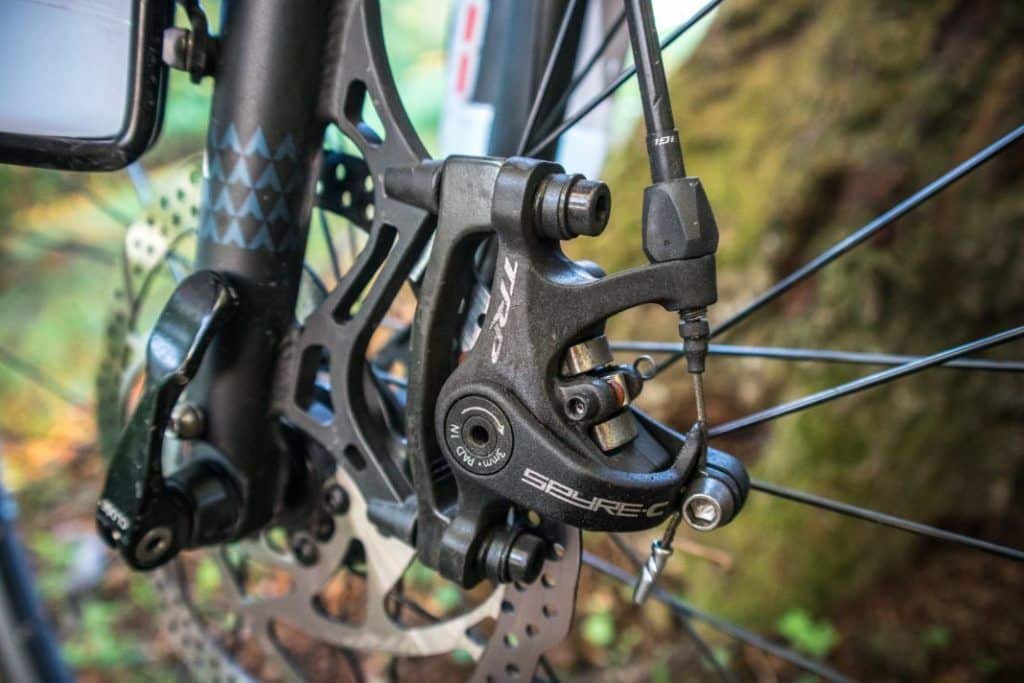
For mechanical brake systems, components from almost any manufacturer can be interchanged. The outer covers and Bowden cables are available in just about every bike shop in the world. Changing the Bowden cables requires simple tools like an Allen wrench or a good bike multitool.
As well as a pair of pliers to clip off a protruding inner cable. The outer covers are also easy to change. For reasons of maintainability, classic touring cyclists prefer mechanical brakes. Because of the more complex maintainability, I was also quite happy that my Bombtrack Beyond came from the factory with mechanical disc brakes. After all, this is exactly the bike for adventures off-road and off the beaten track. For example, I already drove it through Laos and Thailand and circumnavigated beautiful Iceland. These are routes where the supply situation of bicycle parts becomes very thin.
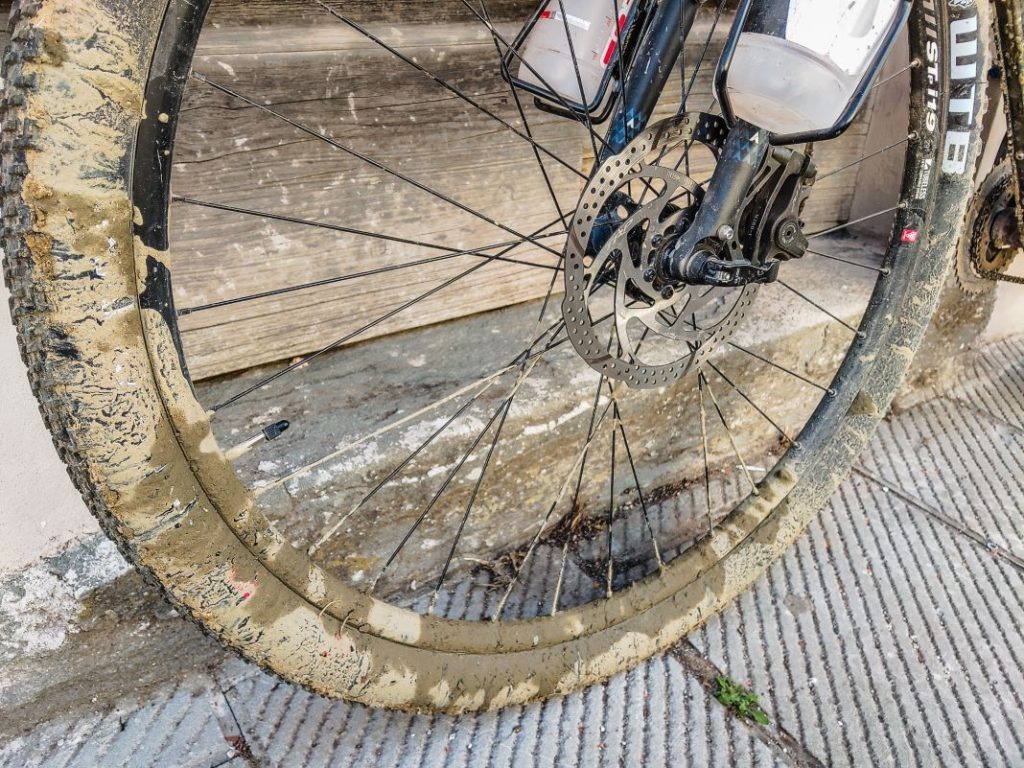
On the Bombtrack Beyond 1 Gravelbike I brake with the quite excellent TRP Spyre C mechanical disc brakes. I am very satisfied with the braking performance: The brakes grip bite. If the brakes are properly adjusted, they will reliably bring the bike to a halt. The braking performance is good and usually perfectly adequate off-road. However, the braking performance does not quite match that of a hydraulic braking system and more power is required for braking.
I have also noticed the following features with the mechanical mock brakes:
All or nothing Feeling: Not quite as fine as with the hydraulic brakes, the braking power can not be controlled. At the beginning of the braking distance you can still play a little with the braking power, then the braking power unfolds completely quite quickly.

Need to readjust the brakes: The readjustment is done quickly but quite annoying. The brake pads wear out over time. This also changes the distance between the brake pad and the disc brake. The brake caliper must be adjusted manually accordingly. With the TRP Spyre C this is done with an Allen key within a few minutes. The allen wrench on my Crankbrohters Mulitool works just fine for this. However, working with the Allen key is – due to the length – more comfortable. In practice, this mechanical disc brake system must be adjusted approximately every 500 kilometers. Up to 1000 kilometers you can also still drive – however, the braking power decreases very much until then.
13 most important questions about the disc brake
Brake pads
What should I consider when choosing brake pads? The choice of brake pads can greatly affect your braking power. Also, different brake pads have different life spans.
Basically there are 2 types of brake pads:
- Organic: Can consist of over 20 carbons from the so-called organic chemistry. Synthetic resin as a basic mass holds these materials together. The mass is then pressed.
- Sintered brake pads consist of fine-grained metal and ceramic particles. These are pressed with a lot of pressure and at high temperatures.
Durability and volume: Due to the material used, sintered brake pads have a longer shelf life. This advantage is especially important in muddy and wet environments. However, the heat development is higher and the sintered brakes tend to squeak more. For better cooling, it’s best to run large 180mm diameter brake discs for better heat dissipation. In addition, many holes on the brake disc improve air circulation.
Organic brake pads are often quieter and cooler, but also wear out faster due to the soft material.
Do not mix brake pads: Ideally, you should not switch back and forth between organic and sintered brake pads. A small amount of the brake pad material settles on the brake disc during braking. The brake disc is contaminated with the material of the brake pads, so to speak. If you switch between the two types of brake discs, the braking force will be slightly reduced. The reduced performance is only minimal but with good planning this can be avoided.
Availability: availability is an important point when going on a long bike trip. In remote areas, I usually carry at least one spare pair of brake pads. This is especially important because there are many different types of brake pads. These are often physically incompatible with each other, i.e. not every brake pad fits into every brake caliper. The best availability for brake pads you have worldwide for the brands Shimano and SRAM.
Brakes are often also compatible with brake pads of these brands. The manufacturers then specify only their own brake pads as compatible, but it also works from Shimano. Example: on my Bombtrack Beyond I use TRP-C mechanical disc brakes with Shimano brake pads. The combination works quite wonderfully.
Sintered brake pads are very readily available in western countries. The best available are, as so often, the brake pads from Shimano and SRAM. Whereby Shimano can be called the worldwide standard.
Please clean your brake caliper before replacing your brake pads. The new brake pads are of course thicker than the old braked down. In order for the brake pads to be installed, the brake pistons must first be pressed firmly outwards. There should be no dirt behind the brake pistons, otherwise the brake system can be damaged.
Number of pistons
What does the number of pistons mean in practice? How many pistons are typically used in bicycle disc brakes? Depending on the caliper, the number of brake pistons will vary. There are brakes with one piston, two pistons or 4 pistons.
- Which brake is the right one for which application
- what braking force can be expected?
- What else is there to consider?
Modern bicycle disc brakes are usually 2-piston brakes: at each caliper are two pistons, which press the brake pads inward. More pistons means more brake pad area. The larger the brake pad area, the greater the braking force acting on the brake discs. This means that the deceleration force is stronger, i.e. the bicycle comes to a halt more quickly.
You will find the following number of pistons on bicycles:
Disc brakes with pistons that move on one side:
2-piston brake: Most modern bikes are equipped with 2-piston disc brakes. Also, most cross country mountain bikes and also many downhill mountain bikes are equipped with 2-piston brakes. Especially with large brake discs, the braking power is excellent and the brakes have a weight advantage, compared to disc brakes with several pistons.
4-piston brake: These disc brakes are used in particular on gravity mountain bikes or on tandems.
Availability: Due to the popularity of 2 piston brakes, the brake pads are also the easiest to obtain. Especially brake pads for 4-piston brakes are rather exotic. If you are going on a long journey, stock up on spare brake pads beforehand.
Mounting standard for bicycle disc brakes
What are the mounting standards for disc brakes? The two mounting standards for bicycle disc brakes are called Post-Mount and IS2000. The two standards differ in appearance and the standards allow different sized discs to be used. :
Post Mount – mounting points are 74.2 millimeters apart: This standard comes from the mountain bike sector. Just about every mountain bike is equipped with post mount calipers. With the Post-Mount Standard, you are on the safe side when travelling by bike or when bikepacking. Quite simply, these can be used to install bicycle disc brakes with 180 mm and 203 mm discs. You can stop even a heavily loaded bike with this.
IS2000 – mounting points are 52 millimeters apart: this standard is particularly popular in the road bike sector and for gravel bikes. The close-fitting caliper gives the bike an extra small extra clean look. IS2000 disc brakes can often accommodate discs with maximum 160 mm diameter. With an adapter sometimes fit larger brake discs. If in doubt, check the compatibility with your manufacturer or with the manual of your bike.
Brake disc diameter
Why are there different brake disc diameters? For touring and bikepacking bikes the following brake disc diameters are typical sizes: 160mm, 180mm and 203mm.

Larger brake discs have two main advantages:
- The larger diameter of a brake disc provides greater a larger leverage. On the caliper. This increases the braking power.
- The larger brake disc diameter results in a larger surface area. This allows more heat to be absorbed and transported away from the brake disc.
On long descents, when riding off-road, and when riding with a heavily loaded bike, these features become even more important. The heavier the rider or the bike, the more useful large brake disc diameters are.
For a bike touring bike or a bikepacking bike, brake discs with 180 mm diameter are ideal and offer enough reserve for many occasions.
For really good stopping power on mechanical disc brakes, you can also use the next higher disc diameter. Then the braking performance of your mechanical disc brakes is very close to hydraulic disc brakes..
- typical for road bike: 140mm or 160mm
- typical for cyclocross: 140mm or 160mm
- typical for MTB: 180mm or 203mm
- typical for gravel bikes: 160 or 160mm
- typical for trekking bikes: 160mm or 180mm
Disc brake adapter
What are disc brake adapters for? There are numerous adapters for the two standards Post-Mount and IS2000. An adapter is used to increase the distance between the following components:
- Front brake: Distance between brake caliper and bicycle fork
- Rear brake: Distance between failing and brake caliper
The goal is always to make more room for larger brake rotors. Brake discs up to 180 mm should be fine on most forks & frames. Before the assembly is made, please check absolutely what discs which disc brake diameter is released by your manufacturer.
Maintaining hydraulic disc brakes
How often do hydraulic disc brakes on a bicycle need to be serviced? At least every 10000 km or every year hydraulic brakes should be maintained. Over time, air can enter the braking system, for example. This will reduce the braking power or the brake may fail completely.
For maintenance, the hydraulic brake system should be completely bled and the brake fluid must be replaced.
If your brake levers can be pushed very close to the bike handlebars, then it’s absolutely time to bleed and take care of your hydraulic disc brakes. Adjustments to the brake levers allow them to be set further out. This can delay the maintenance time somewhat. You’ll need new brake fluid and what’s called a Bleed Cup.
On a big bike trip or bikepacking tour you usually don’t have this equipment with you.
Fortunately, taking care of hydraulic disc brakes is a routine job for almost every bike shop in the world.
Brake in
To get the full braking power of the disc brakes, the brake pads must be braked in. Braking in allows the brake pads to outgas and later develop full braking power. If the new brake pads are not braked in they can glaze in use if they get hot and have a greatly reduced braking performance.
For the correct braking procedure, contact the manufacturer of your brake system and brake pads or consult the manual.
So you can proceed while braking in:
- Search for a long descent without traffic
- Accelerate to a fast speed with the bike
- Constantly braking the bike down to a standstill
- Repeat the acceleration and braking procedure approx. 10 to 20 times.
- the brake has probably heated up so much that it can outgas and is now braked in.
- For safety reasons, first fully apply the brakes on one brake and then on the other brake.
Brake pressure point is soft or spongy, why?
The brake pressure point is soft, spongy and the brake levers of the disc brakes can almost be pushed through to the handlebars – why?
A soft or spongy pressure point of the brake levers indicates air in the system. If there is air in the system, the brake levers can also be pushed further towards the bicycle handlebars. For the time being, you can move the brake levers further out.
This can be a temporary solution when you are on a long trip or want to delay the maintenance appointment at the dealer.
Air can enter the braking system in the following situations:
- Transport – especially without transport lock: Wheels have been removed and brake pads no longer have a secure hold. Air can thus easily get past the brake pads into the system.
- Assembly work with removed wheelset: Similar to transport, the brake pads no longer have a hundred percent hold in the caliper. Air can enter the system more easily.
- Extreme terrain use: In extreme terrain, the bike including the disc brakes was properly shaken. This can cause air to bypass the disc brakes and enter the braking system.
- Long standstill: The brakes have not been applied for a long time. This means that the pistons do not readjust automatically and air can get into the system.
Brakes squealing
The disc brakes squeal. Why and how can I solve the problem? The basic prerequisite for quiet disc brakes is the braking of the brake pads. If the disc brakes are correctly applied, the following reasons may be present: Brake discs or brake pads are dirty, e.g. due to chain oil. Cleaning may be possible, but is very costly.
For cleaning, these methods have proven successful:
- Brake discs can be cleaned with alcohol or a suitable brake cleaner.
- Carefully clean and roughen brake discs with sandpaper
If all this does not help then the discs, the brake discs or and or the brake pads must be replaced.
Avoid transport damage
How can I avoid transport damage in general and transport damage in the aircraft? When transporting or flying bicycles with disc brakes, there are a few things to keep in mind:
Often the front wheel is removed for transport. The rear wheel usually remains mounted on the bike. This applies mostly to transport in the car and also in the airplane. Once the brake disc is removed, you should definitely use a transport lock. If the brake lever is accidentally pressed and the brake pads touch each other, they will then stick together incredibly. It is then really difficult to get the brake pads apart again and you can easily damage them in the process. If it does, if it ever does, be sure to use a plastic multitool or other plastic object to do it. Never use a screwdriver or pointed multitool to pry the brake pads apart. If the brake pads stick, then air can simply get into the brake system with hydraulic disc brakes. With the ones with the transport fuse, you prevent that. If you don’t have a transport lock at hand, you can improvise and e.g. clamp a piece of cardboard between the brake pads and secure it with cable ties. Works wonderfully in practice 😉
Theoretically, the discs of the disc brakes can be damaged in flight during transport. These are often existing concerns. In practice, I had already transported my bike many times in the trunk of a car. Also, several of my bikes were packed in boxes or bike cases and checked on the plane as sports luggage. Sometimes the disc brakes were secured with some cardboard. In any case, no damage has ever occurred in practice. This topic can therefore be viewed in a relaxed manner. If you want to be on the safe side, you can unscrew the disc on the bicycle disc brake. On the rear wheel the disc is often protected, e.g. by a bicycle stand, a quick-release lever or, on a touring bike, by a luggage rack. Therefore, I would unscrew the disc at most at the front wheel with a 6 screws of the be can unscrew the disc quite easily with a bicycle multitool you have the Centerlock standard on the bike then it becomes more difficult: You need a bike cassette tool or the help of a bike shop.
Short summary: use for transport a transport lock to prevent sticking together of the brake pads and penetration of air in hydraulic disc brakes. A light protection of the discs on the bicycle disc brake is useful. If you want to be on the safe side then remove the discs.
Caution: Risk of burns: Touching the disc brake
Why should brake discs not be touched? Heat is generated by the friction of the braking force. This can cause the brake discs to heat up considerably. In the flat plane, with occasional strong braking and with little luggage on the bike is that he is heating is the heat of the brake discs rather unproblematic.
If you are on a hard mountain bike tour, enjoying a long downhill ride on your road bike or bikepacking in the mountains with your heavily loaded bike, the brake discs can heat up a lot. Danger of burns! Therefore, follow the simple rule and do not touch the brake disc.
Disc brake compatible wheels
On which wheels can disc brakes be mounted? In the data sheet of the wheels, the compatibility with disc brakes is easily recognizable. With modern wheels, the compatibility to disc brakes is very likely. Wheels without compatibility to disc brakes are now true exotics. Consider immediately whether the wheels are suitable for disc brakes:
- To the left of the scar is the mount for the disc brakes
- The spokes on the wheel run crossed to ensure more stability. Wheels with uncrossed spokes would not have sufficient stability for the braking forces of the disc brakes.
Retrofit disc brakes
My bike has rim brakes. Can I retrofit disc brakes? The following components must be disc brake compatible:
- Bicycle fork
- Impellers
- Bicycle frame
The bicycle fork must have a receiver for disc brakes. If there is no mount for disc brakes, the fork would have to be replaced with a disc brake compatible cable.
The wheels must also have certain features to be stable enough for the braking forces of the disc brake and to be able to mount the brake disc. Just like the fork, the wheels can also be replaced.
Bicycle frame: for the installation of the brake caliper, a corresponding receptacle must be available at the dropouts. If this mount is not available, it is impossible to mount disc brakes on this bicycle frame.
Conclusion – Hydraulic vs. mechanical disc brakes on the bike
Hydraulic disc brakes are on the rise and for good reason: The braking power is enormous and can also be finely dosed! For performance-oriented mountain bikes, disc brakes have therefore long since become established. Disc brakes are also becoming more and more popular in the road bike sector.
There are areas where the supply of new bike parts is thin and in case of a defect you are on your own. The mechanical disc brake certainly has its charms here. A brake cable can also be quickly replaced in the middle of the bush. However, hydraulic disc brakes have such high reliability and are very puncture-proof and even low maintenance. Thus, in almost every conceivable situation, hydraulic disc brakes are now the best choice on the bike.

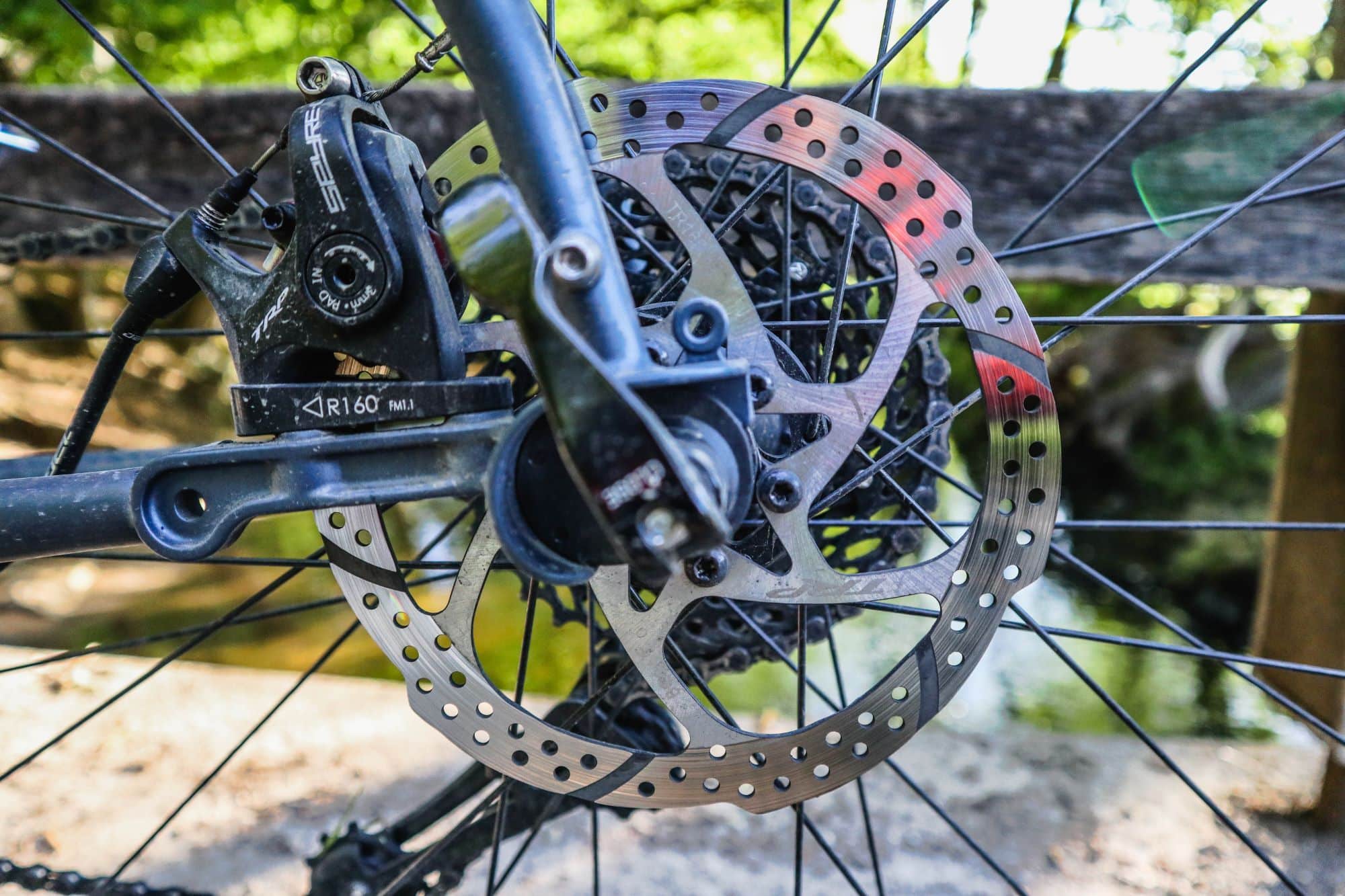
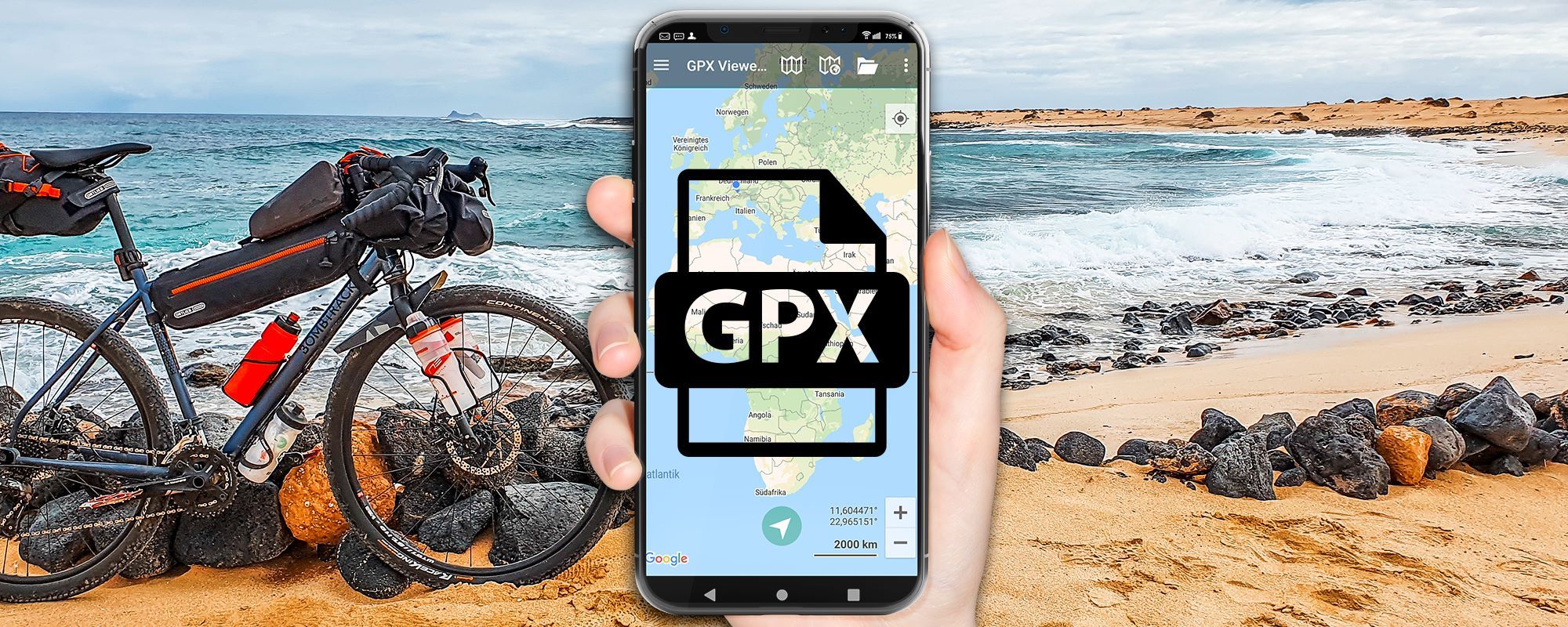

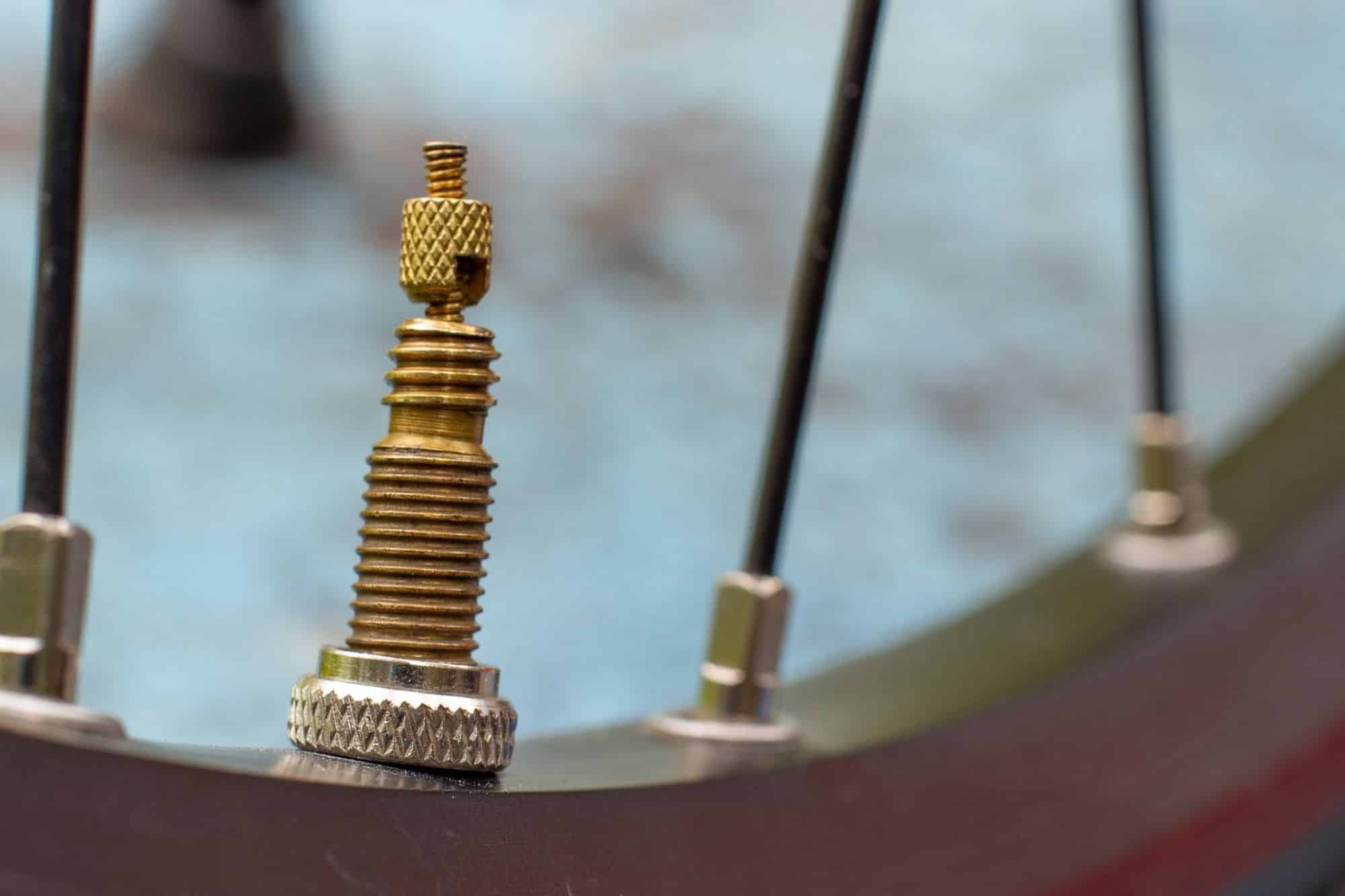
The Differences Between Mechanical and Hydraulic Disc Brakes: Hydraulic Disc Brakes have Hydraulic systems work with fluids. This type transfers force from the lever to the caliper, giving you a greater braking or gripping power level. Hydraulic systems work with fluids and transfer force from the lever to the caliper, giving you a greater braking or gripping power level. They offer maximum braking power that you can easily control. Compared to hydraulic disc brakes, mechanical disc brakes are quite basic. They are also known for being lightweight, which vouches for comfort and stability on your trip. In terms of budget, I recommend this brake type as they are way cheaper than others.